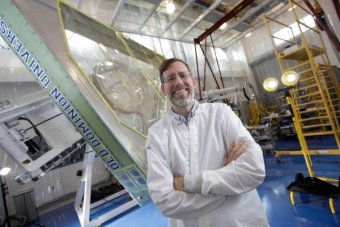By Keith Pierce
Co-led by Lawrence Weinstein, Eminent Scholar and professor of physics at Old Dominion University, a study by researchers at the Thomas Jefferson National Accelerator Facility (Jefferson Lab) is featured in the current edition of the scientific journal Nature.
The article, "Probing the core of the strong nuclear interaction," is a study of the strong nuclear force - one of the four fundamental forces in nature, along with gravity, electromagnetism and the weak force. The strong nuclear force is responsible for binding together the protons and neutrons that form the nucleus of atoms, and therefore the core of every atom that builds our visible universe.
"I want to find out how protons and neutrons behave in the nucleus of the atom," Weinstein said. "In some ways, they behave like people; when they are far apart, they ignore each other, when they are close, they can attract, and when they get too close, they repel each violently."
As pairs of protons and neutrons get very close together, they may make a short-range correlation, forming a brief partnership. While in this correlation, they overlap momentarily before the particles separate.
"We studied protons and neutrons that 'got too close' to find out what really happens in these extreme conditions, which are similar in some ways to those of a neutron star," Weinstein explained. "We found out, surprisingly, that protons still behave like protons, even when they overlap with other protons or neutrons. In contrast, cars stop behaving well when they get too close to other cars and 'overlap' them."
Particularly close interactions between protons and neutrons are rare. Detecting them requires pummeling atoms with a huge number of extremely high-energy electrons, a fraction of which might have a chance of kicking out a pair of nucleons (protons or neutrons) moving at high momentum - an indication that the particles must be interacting at extremely short distances.
"Until this work, the forces between protons and neutrons at very, very short distances comparable to the size of the proton and neutron itself were very model dependent," explained Axel Schmidt, a former MIT postdoctoral researcher and the paper's lead author, who has since moved to George Washington University. "We've come up with a new way to analyze data from Jefferson Lab to look at these forces at distances that are much, much shorter."
In their analysis, the researchers captured snapshots of these correlations to study as microcosms of dense nuclear matter. They then tested different state-of-the-art models for the strong nuclear force to see how well the models explain the data.
They found that the most successful models describe the strong nuclear force at short distances as having a so-called tensor interaction, where protons interact with other protons very differently than they interact with neutrons. Then, as the distance between the correlated particles shrinks even further, the nuclear force interaction changes to a so-called scalar interaction, where proton-proton and proton-neutron interactions are very similar.
The result also has implications for the structure of neutron stars, where it's expected that protons and neutrons overlap much as they do as in the short-range correlations studied in the experiment.
"That's a huge triumph for modern nuclear physics because nobody expected this model to have any connection to reality at this distance scale," said Or Hen, an assistant professor of physics at MIT and spokesperson for the collaboration, in a press release.
According to the researchers, the next step is to see if these results hold up when they can run the experiment again on a wide range of nuclei and at higher precision with the newly upgraded CEBAF accelerator and experimental equipment in Jefferson Lab's Experimental Hall B. The experiment has been approved for running and is awaiting scheduling.
The analysis was carried out as part of the Jefferson Lab Hall B Data-Mining project, supported by theU.S. Department of Energy's Office of Science. The research was also supported by the National Science Foundation, the Israel Science Foundation, the Pazy Foundation, the Chilean Comisión Nacional de Investigación Científica y Tecnológica, the French Centre National de la Recherche Scientifique and Commissariat a l'Energie Atomique, the French-American Cultural Exchange, the Italian Istituto Nazionale di Fisica Nucleare, the National Research Foundation of Korea, and the UK's Science and Technology Facilities Council.
Other ODU researchers include Florian Hauenstein, postdoctoral research associate; Moskov Amaryan, professor of physics; Mohammad Hattawy, research assistant professor; Mariana Khachatryan, physics graduate student; Yelena Prok, visiting assistant professor of physics; and Zhiwen Zhao, former ODU postdoctoral research associate now at Duke University.
See the Nature article here.




